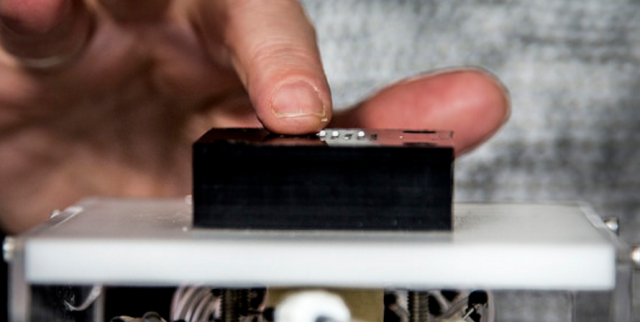BTN.com LiveBIG Staff, February 6, 2016

It?s a major literacy crisis in the United States that?s gone largely unnoticed for several years now: In 2011, the American Printing House for the Blind reported that out of the nearly 60,000 legally blind people aged 21 years and younger, a third were non-readers.
Of the remaining two-thirds, 27 percent could still see well enough to read visually, and 21 percent were pre-readers. Fewer than 10 percent said braille was their preferred method of reading. There are several reasons why braille has declined as a writing system for the blind, ranging from fewer educational resources to the rise of accessible audio technology.
?There are a number of reasons why being braille-literate is important for any blind person,? explained Sile O?Modhrain, a professor at the University of Michigan?s School of Music, Theatre and Dance and School of Information, who?s blind herself. ?Firstly, being able to read literary braille opens up the possibility of having access to other braille codes such as math, science and music-notation systems. This in turn expands the number of areas that blind individuals can gain expertise in, and may ultimately open up a wider range of careers for them.

?Secondly, as research on reading comprehension has shown, reading something yourself is not the same as having something read to you. For this reason, the experience of encountering text via speech (e.g., using a screen reader on a computer or mobile device) is not equivalent to reading a text for yourself. For many everyday situations, this may not matter too much. But for deep reading for learning, it is likely to be just as much of an issue for blind readers as has been demonstrated for those reading standard printed text.?
O?Modhrain is part of an interdisciplinary team at the University of Michigan that?s working to reverse the decline in braille usage. They?re developing prototype devices that use ?microfluidic logic? - essentially, small computer chips that can be used to refresh sequential screens of braille text. The screens are molded with soft materials, and every pixel has a ?memory location,? said Brent Gillespie, a mechanical engineering professor at Michigan.
The challenge is not solely one of technology, he added. Braille reading devices with similar functionality currently exist, but they cost around $5,000. Additionally, they?re of a size that makes carrying them around impractical.
?It?s pretty interesting that in the field of blind-user interface, there are products that are pretty advanced and do what they?re supposed to pretty well,? he said. ?The problem is packing it all in and making it cheap. Actuators are expensive and take a lot of space.?
Interestingly, Gillespie and O?Modhrain worked together prior to their respective arrivals in Ann Arbor. They were both graduate students at Stanford University during the early- to mid-1990s, and collaborated on digital-audio projects while there. So after O?Modhrain joined the Michigan faculty approximately five years ago, it didn?t take them long to get this project going.
?The opportunity to reestablish our research collaboration as a result of coming to Michigan was very fortunate and has been very productive for both of us,? she said. ?Having known and worked together at Stanford meant that we were able to establish a solid research program very quickly.?
Institutional support in the form of funding from the university?s MCubed initiative was also beneficial for getting the research off the ground.
?That was an initial $60,000, which was very helpful for getting us started,? said Gillespie, adding that a subsequent grant from the National Science Foundation has kept the project going for three years now.
[btn-post-package]They still has a long way to go - Gillespie estimates four or five years - before the device is compact and cost-effective enough to be commercialized. But the team members are dedicated to seeing it through. That includes graduate student Alex Russomanno, who works on the design and fabrication of pressure-controlled tactile bubbles that raise and lower braille dots on the screen.
?My current plans after I get my degree are to pursue the commercialization of the technology we?ve been working on,? he said. ?As such, I will be staying involved with the project from a research or business standpoint, ideally both.?
By Brian Summerfield







 Basketball is back! Find available live games on our B1G+ app via BigTenPlus.com.
Basketball is back! Find available live games on our B1G+ app via BigTenPlus.com. 